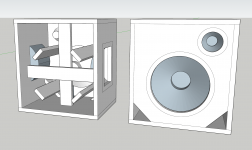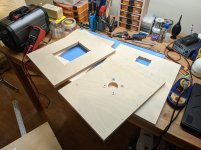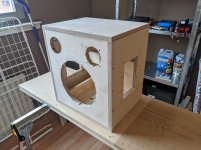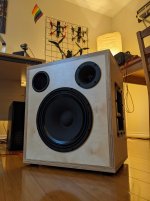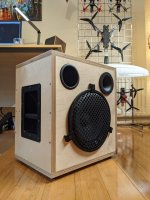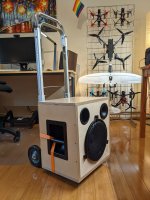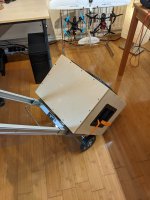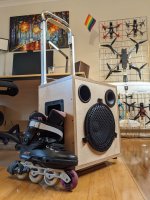I've been toying around with the idea of building a new boombox, now that I spend many evenings outdoors on inline/roller skates with my friends.
My first thought was to build a Halfinator, however the more I thought about it & the places that we skate, the more I realised that I actually don't really want 360 coverage & I would rather have lower extension than super long run time. If I can achieve 2 hours from a 180Wh lithium battery (which I already have), that's enough. The P-Audio drivers for the Halfinator are also unobtanium right now & the neo Eminence alternative are £100 each, which is far more than I want to invest in this project.
The overall size of the Halfinator seems like a good balance though, so I started looking at making a single 10" + tweeter in a similar or slightly larger enclosure. I came across the Beyma SM110/N (now discontinued, but still available & only £60) which seemed to have a good balance of low enough qts & resonant frequency to get a bit more bass than the Halfinator, while still having way more sensitivity (95dB) than hifi or car woofers. I quickly simulated a 25l cabinet (very roughly 30l minus driver, port, etc.) tuned to somewhere around 55Hz & got an f3 of 62Hz with a bit of a bump around ~115Hz.
This was starting to look promising, until I realised that this driver is only available in 8 ohms & to stand any chance of getting enough volume I'm surely going to need to be driving 4 ohms?
So I'm now at a bit of a loss. I can't really find any PA drivers around 8-12" with suitable TS parameters & which are available in 4 ohm. Using hifi or car woofers means dropping down into the region of 85dB sensitivity, at which point am I better off just using something like the Beyma in 8 ohm?
tl;dr - I want something <30l, which will put out more bass than a Halfinator & run for >2 hours on a 180Wh battery.
My first thought was to build a Halfinator, however the more I thought about it & the places that we skate, the more I realised that I actually don't really want 360 coverage & I would rather have lower extension than super long run time. If I can achieve 2 hours from a 180Wh lithium battery (which I already have), that's enough. The P-Audio drivers for the Halfinator are also unobtanium right now & the neo Eminence alternative are £100 each, which is far more than I want to invest in this project.
The overall size of the Halfinator seems like a good balance though, so I started looking at making a single 10" + tweeter in a similar or slightly larger enclosure. I came across the Beyma SM110/N (now discontinued, but still available & only £60) which seemed to have a good balance of low enough qts & resonant frequency to get a bit more bass than the Halfinator, while still having way more sensitivity (95dB) than hifi or car woofers. I quickly simulated a 25l cabinet (very roughly 30l minus driver, port, etc.) tuned to somewhere around 55Hz & got an f3 of 62Hz with a bit of a bump around ~115Hz.
This was starting to look promising, until I realised that this driver is only available in 8 ohms & to stand any chance of getting enough volume I'm surely going to need to be driving 4 ohms?
So I'm now at a bit of a loss. I can't really find any PA drivers around 8-12" with suitable TS parameters & which are available in 4 ohm. Using hifi or car woofers means dropping down into the region of 85dB sensitivity, at which point am I better off just using something like the Beyma in 8 ohm?
tl;dr - I want something <30l, which will put out more bass than a Halfinator & run for >2 hours on a 180Wh battery.
You lose only 3dB by going to 8ohm (assuming a voltage limited amplifier). 12FW76 is available in 4ohm:
12FW76 LF Drivers - B&C Speakers
but it looks like the overall box would be a bit bigger than you want (40L recommended).
12FW76 LF Drivers - B&C Speakers
but it looks like the overall box would be a bit bigger than you want (40L recommended).
Couldn't easily find how much bass a Halfinator puts out.This was starting to look promising, until I realised that this driver is only available in 8 ohms & to stand any chance of getting enough volume I'm surely going to need to be driving 4 ohms?
tl;dr - I want something <30l, which will put out more bass than a Halfinator & run for >2 hours on a 180Wh battery.
The light weight, relatively inexpensive B&C 10CL51 in 30L Fb 60Hz can hit around 94dB in the 60-100 Hz range one watt/one meter.
The difference in output between 4 and 8 ohms is at most about 3 dB, not much difference- 50 watts would be 111 db, 100 watts 114dB.
The battery will last twice as long if output is reduced by 3dB
This thread has lots of good information for what you are trying to do, though a slightly larger box:
Backpack challenge
Have fun!
Art
How about this one?
"Open 1001" - ein Open Source 1/10 PA Top von H-Audio, Projekte der Nutzer / Eigenentwicklungen - HIFI-FORUM
The driver is an elder audio you can buy at Thomann for 38 pounds.
the box Speaker 10-250/8-A – Thomann UK
The tweeter is archived but still available in some shops in germany. However you you may can use this one instead, which is useable from 2,5 khz for pa purpose.
P-Audio : P-Audio PHT-407N :: PS21.55 IN STOCK (13 Jul 2021)
Because the original tweeter ist crossed at 2,5 khz it should also function. Mind that still tho you have to build a new crossover for it!
All in all it should well play in 30 liters.
Greets Swany
"Open 1001" - ein Open Source 1/10 PA Top von H-Audio, Projekte der Nutzer / Eigenentwicklungen - HIFI-FORUM
The driver is an elder audio you can buy at Thomann for 38 pounds.
the box Speaker 10-250/8-A – Thomann UK
The tweeter is archived but still available in some shops in germany. However you you may can use this one instead, which is useable from 2,5 khz for pa purpose.
P-Audio : P-Audio PHT-407N :: PS21.55 IN STOCK (13 Jul 2021)
Because the original tweeter ist crossed at 2,5 khz it should also function. Mind that still tho you have to build a new crossover for it!
All in all it should well play in 30 liters.
Greets Swany
Okay, if using 8 ohms won't be a disaster that certainly opens up a lot of options. This could actually work!
I've been thinking more about size/construction, trying to learn from previous woodworking projects (I'm still a relative amateur with the tracksaw). The plywood that I can buy locally & which fits in my car comes in 80x40cm sheets, so using 40cm as a common dimension will make construction a lot faster. I've come up with a simple box that is ~38l internal volume before subtracting drivers, port, bracing, etc. so roughly 33l effective space.
The 10CL51 looks very promising & if I'm reading the spec sheet correctly is less than half the weight of the Beyma (on account of being neo). Not much more expensive either!
Assuming 33l & 60Hz, the 10CL51 is much flatter than the Beyma & hits almost the same f3 of ~58Hz. First port resonance with an easily available 75mm diameter port is ~3KHz which would work with something like the PHT-407N crossed at 2.5KHz.
However WinISD is telling me that the port will only be 56.4mm long, which is very short. Are there any issues with such a short port?
I've been thinking more about size/construction, trying to learn from previous woodworking projects (I'm still a relative amateur with the tracksaw). The plywood that I can buy locally & which fits in my car comes in 80x40cm sheets, so using 40cm as a common dimension will make construction a lot faster. I've come up with a simple box that is ~38l internal volume before subtracting drivers, port, bracing, etc. so roughly 33l effective space.
The 10CL51 looks very promising & if I'm reading the spec sheet correctly is less than half the weight of the Beyma (on account of being neo). Not much more expensive either!
Assuming 33l & 60Hz, the 10CL51 is much flatter than the Beyma & hits almost the same f3 of ~58Hz. First port resonance with an easily available 75mm diameter port is ~3KHz which would work with something like the PHT-407N crossed at 2.5KHz.
However WinISD is telling me that the port will only be 56.4mm long, which is very short. Are there any issues with such a short port?
A small, short port can be "blown out" at high power.WinISD is telling me that the port will only be 56.4mm long, which is very short. Are there any issues with such a short port?
If the port velocity is more than around 20 meters per second at the power level you plan to use, you should go with a larger, longer port.
Portable cabinets are generally made of thin material. A pair of triangular corner ports would stiffen up the cabinet, while also making it easy to use larger volume ports. Triangular corner ports tune a bit lower than circular ports of the same cross-sectional area and depth, so a bit less cabinet volume is lost.
WinISD only has options for circular & square ports. Can I simulate a pair of triangular ports as a single square port, or is it not that simple?
Eg if I simulate a single 75x75mm square port, will the length/resonance/velocity be similar if I actually split it into two 75x75 triangular corner ports of the same total cross sectional area?
Eg if I simulate a single 75x75mm square port, will the length/resonance/velocity be similar if I actually split it into two 75x75 triangular corner ports of the same total cross sectional area?
A pair of triangular ports can be simulated as a single square port of the same total cross sectional area.
The FB will be close, probably a few Hz lower than predicted, as they will be used in the corners, which effectively lengthens the port a bit.
Some calculators with "slot port" options include the wall proximity effect, compare them to WinISD to get the idea of the variation in length/Fb.
The FB will be close, probably a few Hz lower than predicted, as they will be used in the corners, which effectively lengthens the port a bit.
Some calculators with "slot port" options include the wall proximity effect, compare them to WinISD to get the idea of the variation in length/Fb.
That makes sense, I now remember learning something about this from when I was designing my first reflex sub with a slot/shelf port along one wall.
I've done a more accurate calculation of effective internal volume & come up with 33.5l (total 38.4l minus drivers, crossover, ports, handles, top hat, bracing, etc.).
The PHT-407N says it can be crossed down to 2KHz. I want to use 2.2KHz because I can buy a cheap ready made crossover at that frequency to save myself a headache trying to source/wrap inductors myself.
Tuning to 60Hz with one 70mm square port at 63.7mm long I get a first port resonance of 2.7KHz & a peak velocity of 17.7m/s at 54.5Hz with 30W input.
Assuming that splitting that one square port into two corner loaded triangular ports will effectively lower the tuning by let's say 2Hz down to 58Hz, that will lower the resonance to 2.37Khz & the peak velocity of 17.4m/s shifts down to 52Hz.
Assuming a 12dB/octave crossover, will that resonance be safe? I don't want to make the ports any smaller to raise the resonance, as that will also raise the velocity which will limit higher power usage if I ever want to use the cabinet on mains power. Is it close enough that if it's an issue I can just use stuffing to increase the apparent volume of the cabinet slightly?
I've done a more accurate calculation of effective internal volume & come up with 33.5l (total 38.4l minus drivers, crossover, ports, handles, top hat, bracing, etc.).
The PHT-407N says it can be crossed down to 2KHz. I want to use 2.2KHz because I can buy a cheap ready made crossover at that frequency to save myself a headache trying to source/wrap inductors myself.
Tuning to 60Hz with one 70mm square port at 63.7mm long I get a first port resonance of 2.7KHz & a peak velocity of 17.7m/s at 54.5Hz with 30W input.
Assuming that splitting that one square port into two corner loaded triangular ports will effectively lower the tuning by let's say 2Hz down to 58Hz, that will lower the resonance to 2.37Khz & the peak velocity of 17.4m/s shifts down to 52Hz.
Assuming a 12dB/octave crossover, will that resonance be safe? I don't want to make the ports any smaller to raise the resonance, as that will also raise the velocity which will limit higher power usage if I ever want to use the cabinet on mains power. Is it close enough that if it's an issue I can just use stuffing to increase the apparent volume of the cabinet slightly?
Attachments
1) The impedance of the B&C 10CL51 is around 12 ohms at 2.2kHz, a "cheap ready made crossover" is likely using parts sourced for an 8 ohm load, and won't result in an acoustic crossover point of 2.2kHz. Probably still close enough for roller skating1) I want to use 2.2KHz because I can buy a cheap ready made crossover at that frequency to save myself a headache trying to source/wrap inductors myself.
2) I get a first port resonance of 2.7KHz & a peak velocity of 17.7m/s at 54.5Hz with 30W input. Assuming that splitting that one square port into two corner loaded triangular ports will effectively lower the tuning by let's say 2Hz down to 58Hz, that will lower the resonance to 2.37Khz.
3)Assuming a 12dB/octave crossover, will that resonance be safe? Is it close enough that if it's an issue I can just use stuffing to increase the apparent volume of the cabinet slightly?
2) Using poly, fiberglass, felt or foam damping in the cabinet, the 2+kHz port resonance will not be excited regardless of crossover frequency, as those reflected frequencies should be attenuated by the damping material.
3) Too much stuffing will reduce the output at Fb, use only enough to eliminate upper reflected (out of phase..) output through the port. Generally, damping material on the back, one side and the top will be plenty.
I would recommend using a circular rather than triangular ports. Reasons:
1. Circular ports have less aerodynamic losses = more bass
2. Triangular ports present more port noise
3. Easy to tune circular ports with cutting PVC pipe.
4. Ability to add roundover (essential IMO) with a router
More complicated to design, (a few extra bits needed), but well worth the effort in my opinion.
The B&C is a neat little driver. Just watch the maximum excursion!
1. Circular ports have less aerodynamic losses = more bass
2. Triangular ports present more port noise
3. Easy to tune circular ports with cutting PVC pipe.
4. Ability to add roundover (essential IMO) with a router
More complicated to design, (a few extra bits needed), but well worth the effort in my opinion.
The B&C is a neat little driver. Just watch the maximum excursion!
1) Circular ports occupy more cabinet volume for the same Fb, less cabinet volume=less bass.I would recommend using a circular rather than triangular ports. Reasons:
1. Circular ports have less aerodynamic losses = more bass
2. Triangular ports present more port noise
3. Easy to tune circular ports with cutting PVC pipe.
4. Ability to add roundover (essential IMO) with a router
2) Possibly, but at 115dB+, I've never noticed it.
3) Cutting wood is about as easy as plastic.
4) Rounding wood with a router is no problem.
5) Diagonal ports stiffen the cabinet, and allow a greater frontal area to be used- a larger triangular port may have less port noise.
Other than that, we agree on all points ;^)
Art
You could rout triangular shape cavities from the plywood, leaving the corners, front panel and areas where braces are fit full thickness, and reduce the raw cabinet weight to that of 10mm while still being stiffer than the thinner plywood.
Takes some time, but for something you may carry by hand, worth it in the long haul.
Takes some time, but for something you may carry by hand, worth it in the long haul.
Made some noise for the first time today & I think I'm going to be quite happy with it once I get the chance to test it properly outdoors. A new mono TPA3116D2 amplifier is on it's way for outdoor battery-powered use, currently testing on a bridged pair of LM3886.
Reading the crossover's datasheet I thought I'd need a 4.7Ω resistor to trim the tweeter down 4dB to match the efficiency of the woofer, but I've ended up using 12.7Ω to get something that sounds balanced (at least in my limited, indoors, on axis, low power, tests).
I don't own a router so the woofer isn't rebated. I'll have to cut some small blocks out of some offcuts to mount the grille neatly.
Reading the crossover's datasheet I thought I'd need a 4.7Ω resistor to trim the tweeter down 4dB to match the efficiency of the woofer, but I've ended up using 12.7Ω to get something that sounds balanced (at least in my limited, indoors, on axis, low power, tests).
I don't own a router so the woofer isn't rebated. I'll have to cut some small blocks out of some offcuts to mount the grille neatly.
Attachments
- Home
- Live Sound
- PA Systems
- <30l boombox, with more bass than a Halfinator but doesn't need to run as long?
